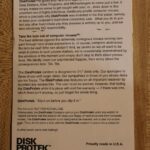I ran across this artifact from a bygone era the other day, and went searching for the story behind it. Surprisingly, I could find no pictures of it, so I decided to record it for posterity. Now future generations will know that terrible computer jokes existed long before facebook, when cavemen had to physically pass the jokes to one another like the very floppy disks the DiskProtek was made to defend.
The only reference to the DiskProtek that I’ve found at all is this trademark registration. It looks like it’s expired and is available for the low price of $159 if you’d like to enter the lucrative Archaic Computer Novelty business.
It hasn’t held up very well, but it’s probably close to 20 years old, so it’s a wonder it isn’t a bag full of dust at this point. Obviously the DiskProtek corporation produced a quality product.
Read on for the text from the back.





